We Drove Tesla’s Model X Into the Eye of the Storm
Tesla claims its new SUV is as good as any road trip vehicle, or better—we headed for the harshest environment possible and took score.

There is never a slow news day for Tesla. Gut punches like the recent SEC violations filed against Resident Genius/Chief Executive Twitterer Elon Musk are offset with firework revelations like the arrival of its much anticipated $35,000 entry-level Model 3.
Smile-and-click-inducing notices of fun updates like “Dog Mode” are balanced with announcements of Tesla’s plan to pivot completely online with purchases, closing down most of its Apple Store-like “dealerships”.
There is so much hype in the Universe of Tesla that sometimes we all forget that in the end it’s all about the cars. So we decided it was time Maxim.com dug deep into the nuts and bolts — or rather ions and lithium — of the matter and get to know the product in the real world.
Tesla offered a chance to test their Model X’s new futuristic Navigate on Autopilot feature on an extended drive, and we jumped on the opportunity. But instead of just driving the flagship Model X P100D around town, why not assess the zero emission SUV’s real-world roadtripability from a Big Picture perspective?
Yeah, we made up that word but it makes sense. It wasn’t just the advanced NavOnAuto we were interested in testing—a system some say is the closest we’ve yet gotten to *robot cars —we had other burning questions.
For instance, how robust and viable is its vaunted Supercharger network? Are there enough stations to make a 1,000-mile route in an EV as convenient as in a vehicle with a traditional internal combustion engine (ICE)? How often, if ever, would range anxiety strike as we decoupled from traditional gas stations?
Due to the fact we were driving into one of the coldest areas of California during the coldest month of the year, there were other dynamics we would put to the test as well.
https://www.instagram.com/p/Btrm91hFPy8
How would the luxury EV’s batteries and electric powertrain, never mind its basic creature comforts, hold up in the crucible of freezing temperatures? How would Tesla’s vaunted AWD and traction control work in snowy weather conditions? And was this five-seater EV (up to seven seats optional), the only true midsize zero-emission SUV currently on the market, roomy enough to transport three grown men and all their gear for five days, gaining and dropping some 20,000 feet of elevation along the thousand-mile-plus trek?
We decided to head straight into the mountains to two of California’s best ski resorts, Mammoth and Heavenly, to put the rubber to the road.
The course we devised seemed like a perfect trial for all these variables in some real world environments—but as February plummeted to the coldest month in Southern California in over 60 years, absorbing a record 25 feet of snow in a month (locals dubbed it Februburied)—what we did not predict was that those conditions would be among the harshest and most challenging we could have ever have hoped for/feared.
Navigate on Autopilot
We are living in the future, and it’s happening in front of our eyes faster than we could’ve ever seen coming.
“Holy shit!” Frontseat Bill blurted as we activated the Navigate on Autopilot pulling onto the onramp of the 405 North, and the Model X P100D merged into the freeway with no steering aid whatsoever. As an automotive journalist I’ve had the privilege of sampling similar systems from the likes of Audi, Mercedes-Benz, Volvo and Cadillac, but guys like Bill have never seen it firsthand—and he and Backseat Matt were understandably blown away.
The Model X not only merged into traffic, but it kept perfectly centered in the lane and continued to drive (with my hands on the wheel) for five miles without tremor.
We set the speed to 75 mph (Navigate has a 90 mph max) and the X drove at that velocity until it approached a car in the lane ahead; there it would slow and keep a safe distance (the exact distance adjustable by twirling a dial on the Autopilot stalk). You can see this all transpire on the cluster gauge display, where the X is illustrated on a digital road with cars approaching from behind and ahead, all picked up by the SUV’s 8 cameras, 12 sonar and single radar.
https://www.instagram.com/p/BiR3r0AlxwM
If the car ahead continued driving slower than we liked, we could initiate a pass by pushing the blinker left, and the Navigate system would read traffic and wait for a safe moment to move into the passing lane. Once there it would accelerate until it reached our set speed and continue steadily (max velocity is easily adjustable by pushing up or down on the Autopilot stalk to increase or decrease speed by 5 mph increments).
Backseat Matt, who spent most of the trip testing out the X’s rear passenger comforts, leaned over my shoulder to see the lane changing with his own eyes.
“Did you just turn the wheel, or did it move on its own?” he asked incredulously.
I assured him I did nothing more than push the blinker right as we moved back from the passing lane to the second cruising lane.
Let’s just get it out of the way and say Tesla’s updated Navigate on Autopilot is the best driver assist system we have ever tested, across all brands (with Cadillac’s Super Cruise a close second).
This is the closest we’ve yet come to self-driving cars, and although I want to stress it is NOT self-driving, if you keep an eye on the system and stay alert—every 30 seconds or so the system will ping you to rotate the wheel slightly to notify the car you’re still paying attention—for extended periods of time Navigate will handle most of the driving (throttle, steering, braking) for you.
How It Works
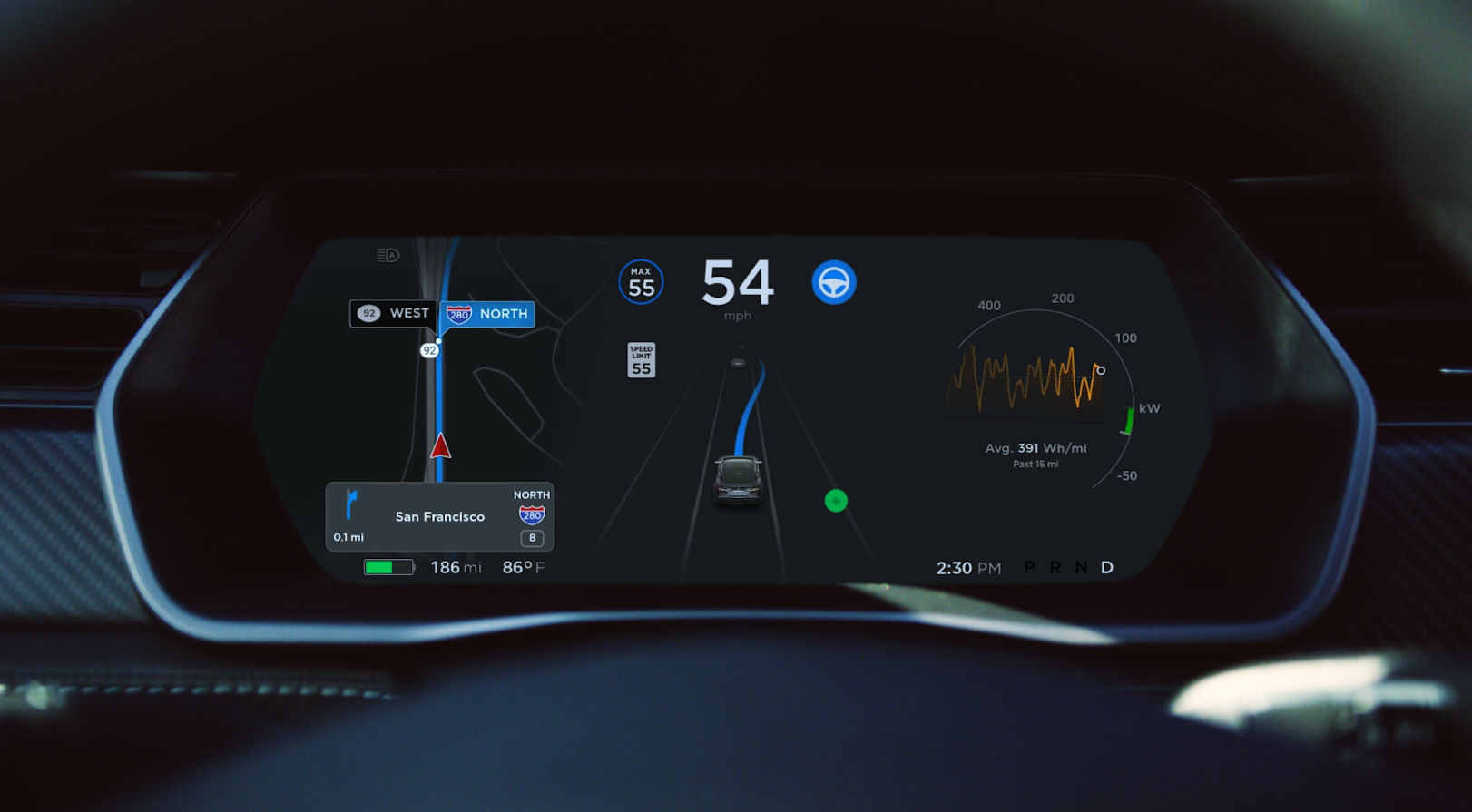
Navigate on Autopilot is 100 percent geofenced to unrestricted freeways. One click back on the Autopilot stalk will engage a more traditional Cruise Control (i.e. distance, throttle and braking), and two clicks will initiate Navigate for Autopilot (i.e. Auto-Steer) — which can be activated as soon as you hit the on-ramp.
From that point on, the X will help you merge, suggest lane changes (to both overtake slower moving traffic and to get you onto the correct interchanges), and maintain steady speed and safe distance from the vehicle ahead.
Once you are coming up to your exit, the cluster display will notify you via a grey line in the digital highway illustration. As you approach, the car will turn on its indicator and take the correct exit.
Presently you have to push the blinker for the X to change a lane, but Tesla tells us future versions of Navigate will allow drivers to turn off this “Stalk confirmation” feature allowing the X to change lanes without a confirmation.
The idea is to first familiarize drivers with automatic lane changing in this version of Navigate—and make sure they’re paying attention at the exact moment they need to—before scaling to more autonomy.
Regardless, the Freeway Interchange feature did not work perfectly for us, as on the 405 North to 5 North interchange the X put us in a middle lane that could not access the 5 North, only the 5 South, so we had to take back control at the last second and exit the wrong freeway direction.
When we told Tesla about this, they said the system is only 4 months old (released October 26 of last year) so it is still in the “Fleet Learning” stage and maybe incorrectly calculated that particular lane could access both north and south ramps.
Supercharging Network
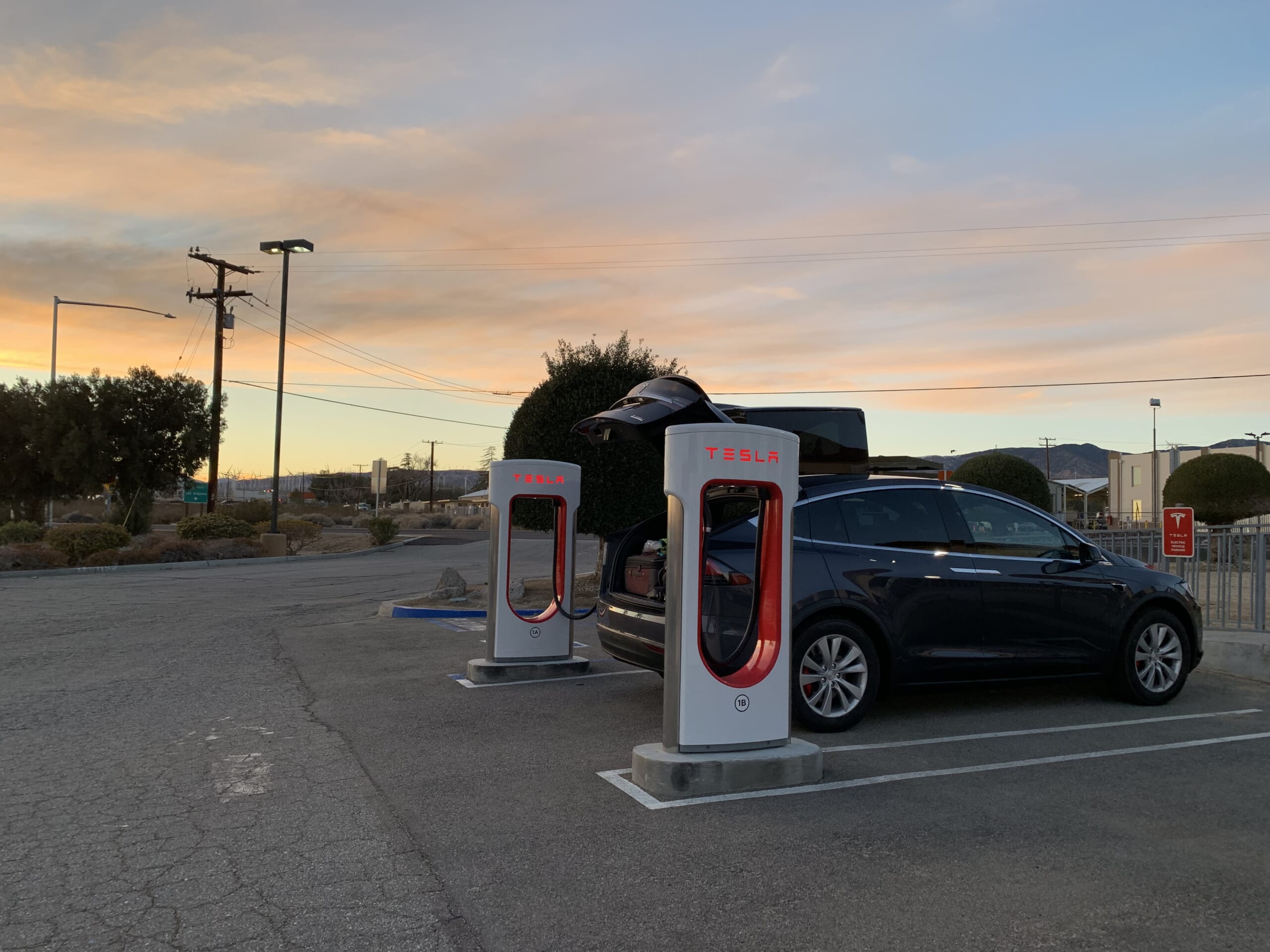
While NavOnAuto’s beta version is a very new feature and is clearly working out some kinks (as intended), one of Tesla’s most fundamental investments performed superbly.
As of press there are some 12,000 individual Supercharger stalls at over 1,400 locations worldwide (613 stations and 5,675 stalls in the USA alone)—and Tesla is eager to show it can make road trips as convenient for its drivers as those of conventional ICE vehicles.
Simply plug in your destination and the X will build your charging plan for you, taking almost all the guess work out of the charge plan. It will calculate how to arrive to the destination in the quickest amount of time taking into account temperature, traffic, elevation change, etc., virtually modeling your route in real time.
So if you attempted the same trip the following day with a different state of charge in different traffic and temperature conditions, it might build you a different charging plan.
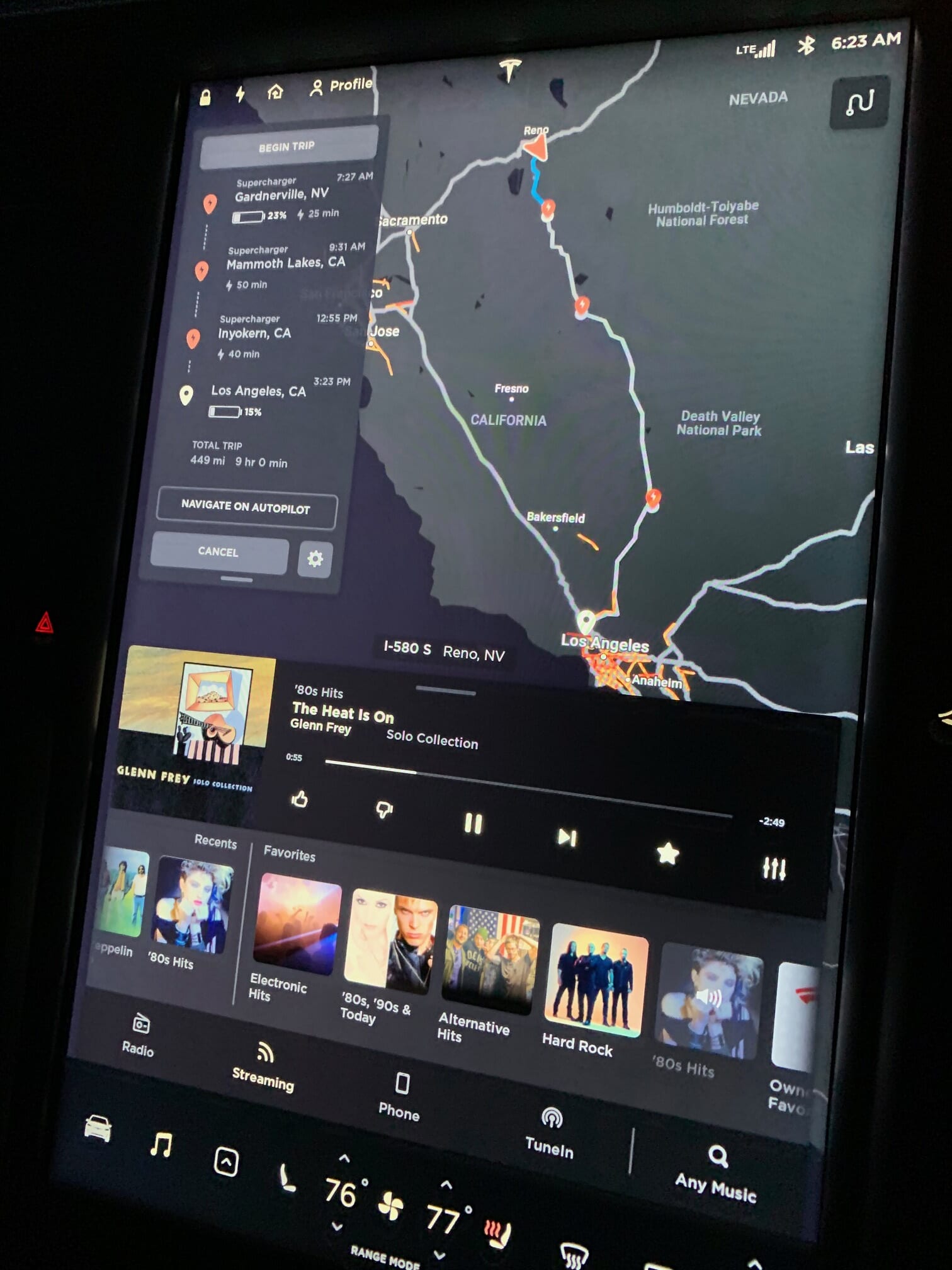
Our plan required a 20 minute charge in Mojave, and a 45 minute stop 100 miles from Mammoth in Lone Pine. In none of our stops were more than 50% of the stalls occupied, and most had only one or two other vehicles. We used the Mojave break to buy water and snacks at the attached Stater Bros, and in Lone Pine stopped for dinner.
Most of the Superchargers were in places with nearby POIs — in Lone Pine it was a Western Film History Museum, with a slew of walkable food options: gourmet pizza, two BBQ joints, burgers, Tex Mex, etc. We chose a spot called The Grill with homemade pasta sauces, fresh salads, and craft beer from the draft (for passengers, naturally).
Two points of note:
1. Other Tesla owners always want to chat, like mutual parents of a rare pedigree at the dog park. This was more helpful than annoying, as they often advised with charging and other questions.
2. At every stop there were always people from the Supercharger bays hanging out — it was almost comical seeing the same people everywhere. Which begs the question of the economic impact these Bays might have on the local micro-environment. If only 1/4 of the daily chargers visit the closest coffee shop or burger joint that could add up to a ton of money for nearby businesses.
Riding a Mammoth (Mountain)

Post-meal we drove another hour to Mammoth Mountain’s Village Lodge, arriving just around 10 pm. After checking in we found the hotel’s Destination parking bays, plugged in the X and unloaded.
These Destination ports are not Superchargers, but rather Level 2 48-amp chargers meant to steadily refill overnight. This was now the third charge of our trip, and should have topped off the Tesla’s batteries in under five hours.
The suite at Village Lodge was comfy and clean, with fireplace, balcony and full kitchen. We had a celebratory round of Don Julio’s Buchanan Cask Reposado and crashed for an early day on the slopes.
Mammoth had been dumped with 16 feet of snow in the previous weeks—almost half of the total snowfall for an average year—and offered an absolutely superb day of skiing. Almost all of its 3,500+ acres of skiing were open, the only areas inaccessible closed due to high winds at the peak.
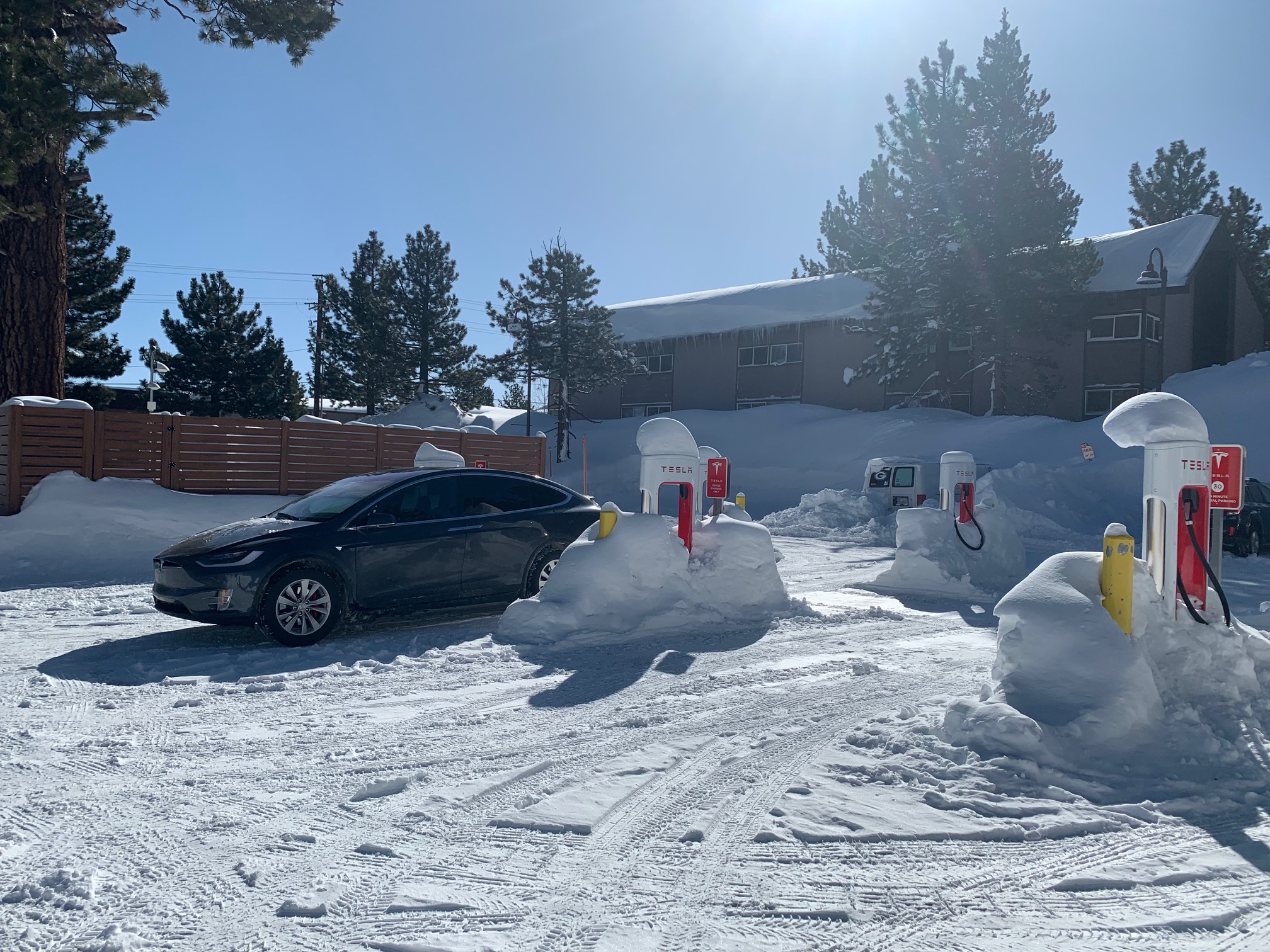
Since it was a Friday, there was zero wait on any of its 28 lifts or 150 trails. Also, since all of Mammoth Village is built around the one resort, everything works in concert to get you onto and off the slopes efficiently.
We skied until the last lift closed and then rushed to the Model X, eager to get on the road as we were warned of a horrendous storm coming that evening. The problem? The Destination charger hadn’t worked as planned, and instead of a full charge we found we only had 180 miles of range for a 140 mile trek. Crap.
So while we cannot criticize the Supercharger network per se as the faulty charger was a Destination version, this certainly dings the overall charging strategy. Tesla explained that several factors can contribute to a bad Destination experience, including weak or faulty outlet circuitry.
Regardless, the final result was that when we wanted to be zooming up in daylight to Lake Tahoe to beat the Mother of All Storms that was bearing down on the area, instead we found ourselves at a local Supercharger twirling our thumbs for 40 minutes while the X’s batteries reached full charge.
Creature Comforts

The 3-hour drive up to Lake Tahoe is yet another chance to marvel at the visceral fun and luxury the X P100D provides. Sure we could have possibly made it to Heavenly with the 180-miles of charge we had, but that would meant austere Energy Saving settings. What’s the fun in that when you have Ludicrous Mode at your disposal?
The P100D’s 100-kWh battery not only offers 289 miles of zero emission driving, it can also launch you from zero to 60 mph in 2.9 seconds — faster than most mid-engine supercars. And while we never aimed to break any speed records, its getup is so thrusty and neck-snapping that you’ll be passing Porsches with a tip of the throttle.
Plus, it’s got great body physics: the battery pack sits underfoot, which not only adds rigidity to the vehicle but also lowers its center of gravity. So although heavy (some 5,500-lbs), the X boasts superb composure and very little body roll. We had about one hour of clean driving before the snow started to fall, and in that hour the hijinx were rich.
There are other remarkable, singular joys of interacting with a Tesla — in a word, its frictionless dynamic. The concept of “removing friction” comes from the tech world, meaning eliminating any point that resists ease-of-use.
This was one of the inchoate characteristics of the brand we marveled at most when we drove the Model 3 this spring. As we wrote then, Teslas accomplish this goal in ways no other automobile can: you simply walk up to the X and it senses your fob and opens the door for you.
Slip inside and the dash lights to life—the only visual sign the X has turned on (there’s no Start button or key ignition)—and the door clicks shut behind you. You’re ready to go; step on the throttle and you’re off. When you’re done driving, simply slip the X into park, exit the vehicle and it shuts off and locks the door behind you.

Frictionless. Locking and unlocking, starting, driving, exiting, Autopilot, etc. In almost every way imaginable, the X opens itself up for you and is ready for use.
After the bull-rush powertrain performance, the most salient aspect of the Model X is its spaceship-like cabin. Not tight and confined like real world Apollo spaceships, mind you—more like the kind you see in James Cameron flicks with giant window bays and superfuture technology.
The X boasts the biggest piece of glass in the auto industry: a windshield and panoramic sunroof conflated into one expansive vertical plate of wonder. The glass is so tall its upper edge sits above your site of vision, so in combo with side view windows offers an almost convertible sensation.
It may be even better than a drop-top because there’s not even a windshield frame breaking up your field of vision—just one smooth uninterrupted horizon. And this visibility rings especially profound as you climb through snowy passes in the gloaming; the serenity and calm it provides is comfort to the bones.
Soon the sun, snow and temperatures dropped, and we were glad we had topped off the batteries as we headed straight to South Lake Tahoe. The snow began dumping, and we had to push through unplowed streets to reach the safety of our cabin.
Cold Weather Battery Performance
https://www.instagram.com/p/BdlKV-7BSIS
A recent AAA study of five electric vehicles (BMW i3s, Chevrolet Bolt, Nissan Leaf, Tesla Model S 75D and Volkswagen e-Golf) found that cold temperatures can temporarily reduce range by more than 40 percent when interior heaters are used—or 12 percent when not used.
Specifically in regard to Tesla, AAA found when fully charged (239 miles) at 75 degrees the range dropped 38 percent (to 148 miles) at 20 degrees. We didn’t find that dramatic an effect, but did see a decrease in performance in our coldest leg of driving during the snowstorm from Mammoth to Tahoe.
In that span the X used 98 miles of range to traverse 91 miles of distance—which means it retained about 93 percent of targeted range.
Tesla noted that it’s not just cold that affects range, but also snow tires that can drop 10-15% efficiency even in ICE vehicles. Other factors like snow resistance and cabin heating can also dramatically affect range, which is why they stressed it’s critical to pre-condition the cabin while the vehicle is still connected to a charger.
Because we were fairly diligent about hitting all charging points as outlined in our plan (we really wanted to keep the X dialed up to Ludicrous Mode, even in snow) we never let our range drop to less than 40 miles. This was not difficult to do in our 1,000 miles of driving, but we will concede that decreased range in cold weather could be an issue if you lived in those areas instead of just visited them.
Cold Weather AWD Performance? Check!
We woke up the next morning and couldn’t believe our eyes. Three feet of snow had dropped overnight, and buried the front yard, driveway and Model X under a mountain of white. We gulped, and sort of feared the adventure ahead.
But one of the fundamental questions of this roadtrip was about to be pushed to its limit: How would the Model X’s AWD architecture perform in the snow?
Well, we found out—and in this capacity the Model X executed better than we could have ever hoped. Snow piled above roof level all around as we slowly made our way down Route 50, where we passed a dozen unqualified vehicles in various states of immobility.
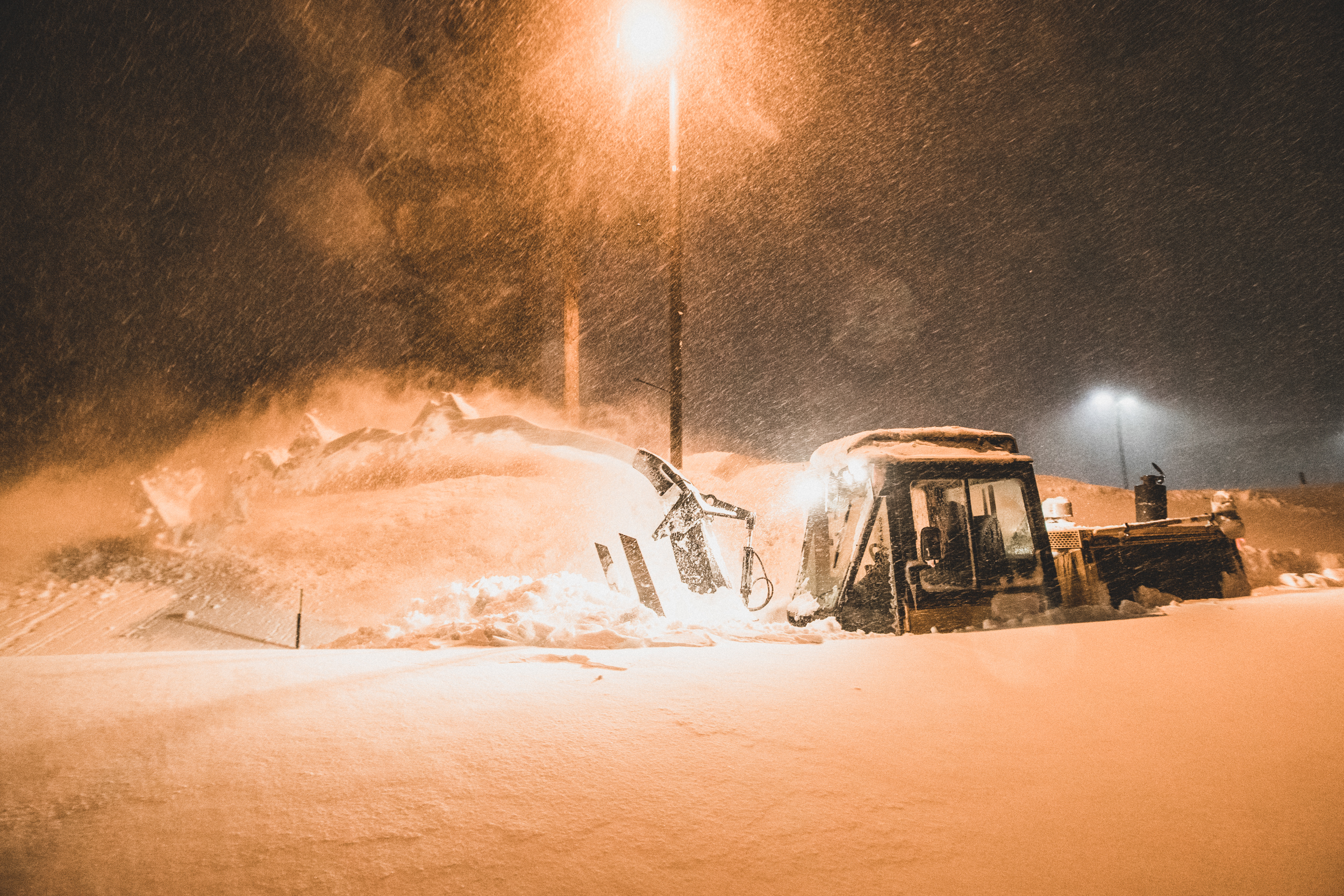
The roads were littered with decommissioned cars, wheels spinning uselessly, swallowed by ice and snow. And not just front-wheel coupes with no business being out, but even numerous SUVs with groups of men huddled around them, breath steaming out of mouths, furiously pushing to detach their transport from a snow bank.
We barely slid (except for a couple driver-initiated drifts), and never experienced tire spin; the X’s standard AWD handled it all with aplomb. It’s also reassuring knowing that with a 5-Star Overall Rating, the X is the safest SUV ever built.
We had swapped out the Model X’s 22” Pirelli Scorpion all season for 19” Pirelli Scorpion snow tires before leaving LA when we’d heard of the potential storms, and thank god—many roads were closed to anything not AWD wrapped in snow rubber or in chains.
https://www.instagram.com/p/BttoS0xldpS
A Heavenly Experience
Of course as bad as snow is for commuters, the inversion is true for skiers. My god, the runs we enjoyed will not be soon forgotten. On our first couple lifts up Heavenly’s California side were over virgin swathes of powder, barely cut with the trails of a couple skis.
A run called Cascade specifically was so intoxicating we literally heard grown men giggling like schoolgirls as they swooshed down, hip deep in luxurious powder. There was a groomed tunnel down the middle, and you could jump from packed snow into powder, back and forth to your little heart’s content, with a smile etched ear-to-ear.
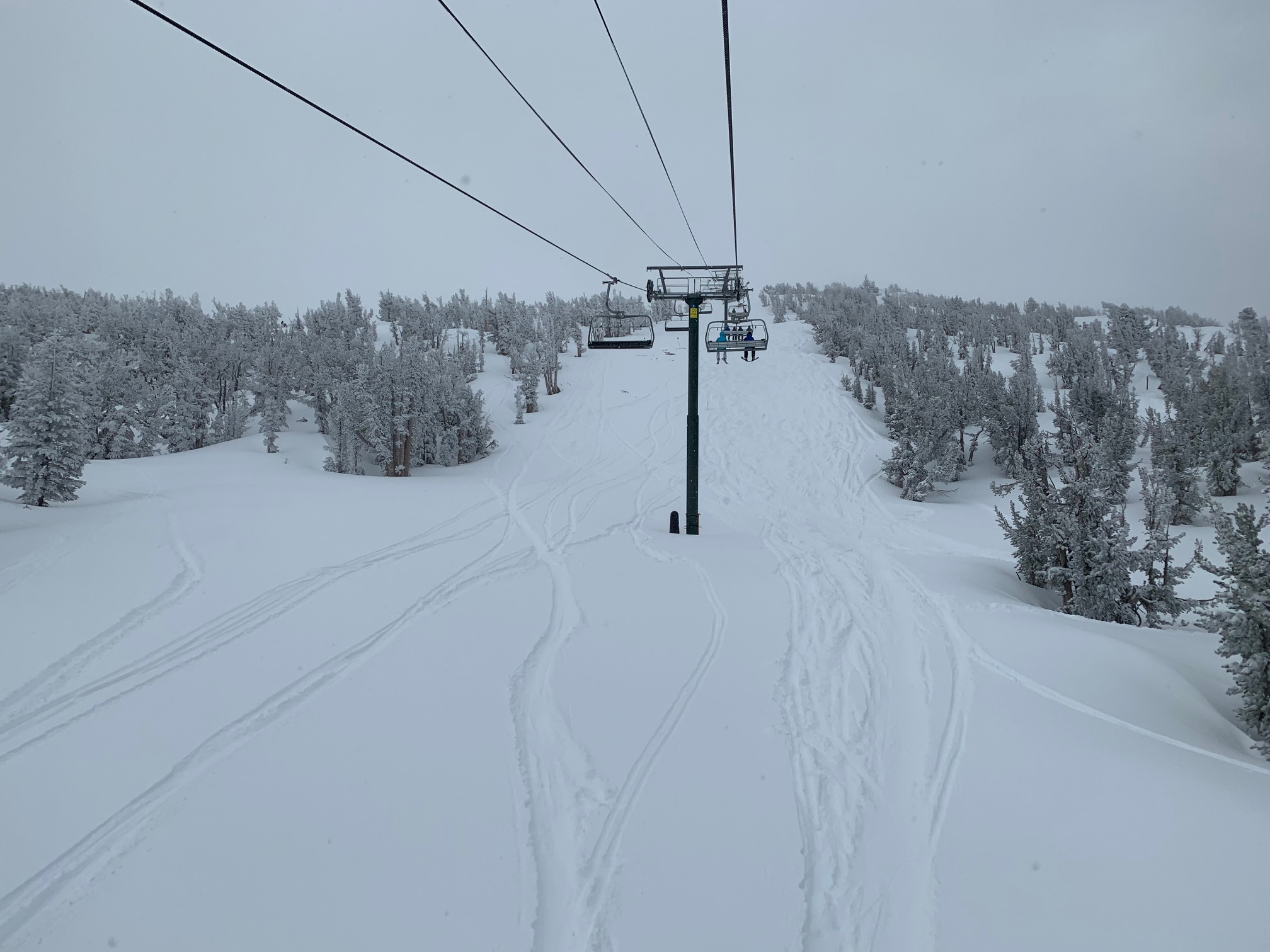
Heavenly features so much wide glade skiing and so many long groomers that you could spend a long weekend there and not hit all one hundred of them. Much like a supercar, however, points have to be knocked off Heavenly when it comes to entrance and egress. Meaning, the parking situation sucks.
If you don’t get there early a mile-long hike is not uncommon, which can be especially painful carrying a full load of gear. The gondola in town is a decent alternative, but parking there can also be expensive and harder to find than El Chapo in a snowstorm.
Unlike Mammoth where the entire village revolves around access to lifts, the varied and robust attractions of Lake Tahoe mean that a couple hours may separate your cabin from the slopes.
Edgewood Restaurant

We decided to celebrate our epic adventure at what many consider the best restaurant in South Lake Tahoe, the Edgewood.
Located on the George Fazio-designed golf course of the same name, the simultaneously cozy yet cavernous restaurant features panoramic windows and giant tree trunks supporting a moonroof. From the floor-to-ceiling glass we looked down at the sapphire lake below, witnessing why the Edgewood was voted one of the 100 Most Scenic Restaurants in America.
During our dinner—which included charbroiled octopus with shaved radish, plump scallops, mouthwatering seared elk chops, and possibly the best gruyere French onion soup we’ve ever had—we witnessed the storm outside slowly swell from a dusting to flurries to a traditional snowfall to dumping to trees being shaken to their core by gales.
By the time we left it was a full-on whiteout.
https://www.instagram.com/p/BuKNDvdAD2U
Cold Weather Limitations? Check!
The winds were so strong as we left the Edgewood we literally had to hold onto our hats. When the valet brought the X around we scurried into the front seats and tried to open the falcon doors to let in Backseat Matt, but they wouldn’t lift.
Matt opined the hinges were frozen shut, but I guessed it was the gale force winds pushing against the door and keeping it from opening. So we turned the X around 180 degrees so the door was sheltered against the wind and it finally opened a couple feet, but still needed our help to physically lift enough for him to enter.
While an amazing feature 99 percent of the time, the falcon doors are not exactly designed for freakish snowstorms. Opening the doors in that tempest meant the entirety of the cabin was blasted in snow, and whether the hinges were frozen or stopped by wind it made for a very challenging escape from Edgewood.
We have to stress however that once inside and driving back to our cabin the X handled the storm with steadiness and grace under pressure — its AWD never failing us, its traction never slipping.
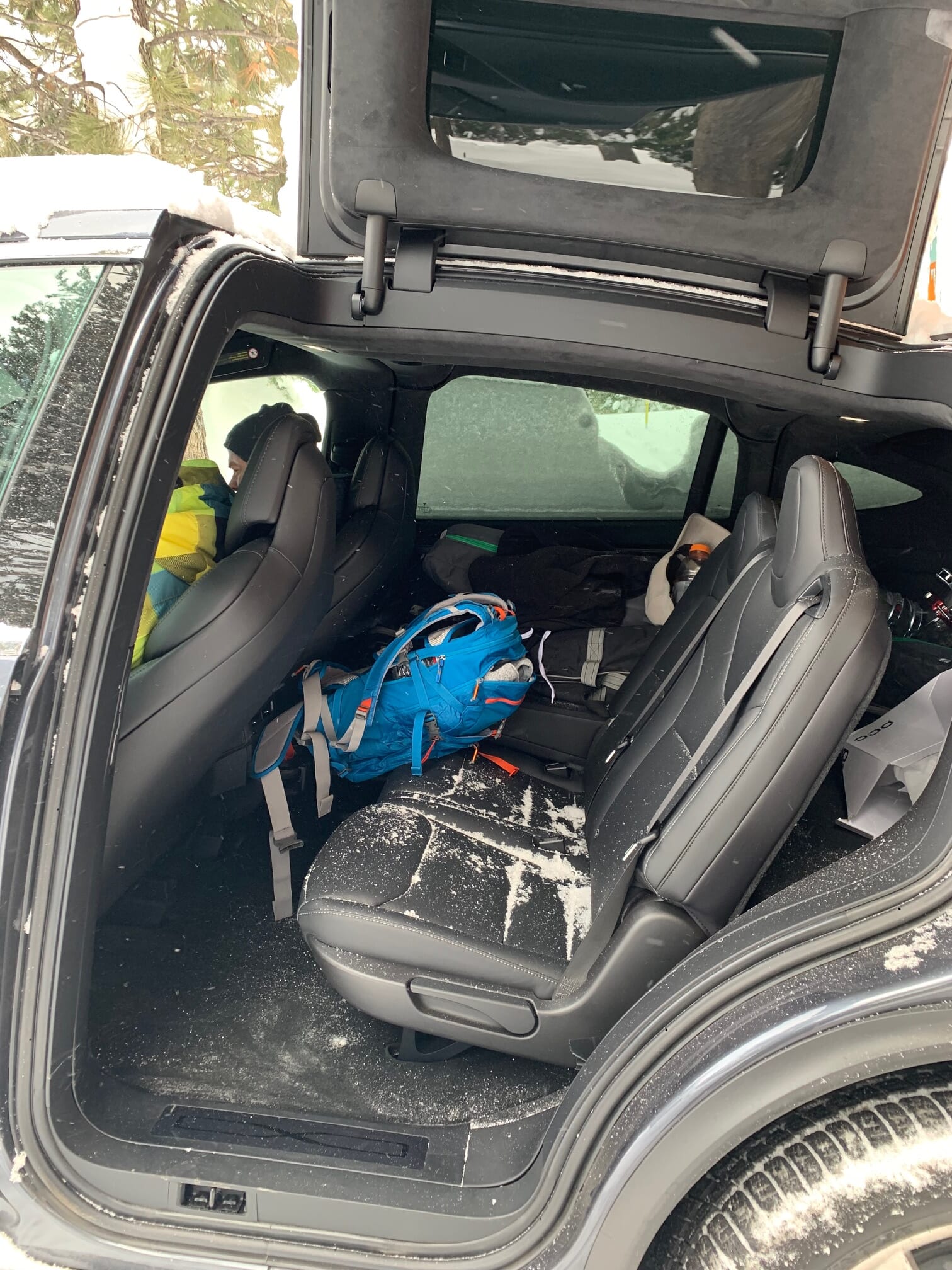
The next morning we faced another avalanche of snow on our vehicle, and once again the inherent design of the falcon doors showed its limitations. It first required us finding a trash can to climb on top of so we could shovel off most of the four feet of snow piled high on the roof, but even after that extraneous effort once we opened the doors fistfuls of snow still fell into the backseat. This is problematic.
One other necessary mention is cabin warmth. With temps dipping down to -18 degrees, the extreme conditions we encountered illuminated some of the X’s deficiencies in this area. This would be a factor in any EV; because every calorie and ion is precious in a battery powered vehicle, they prefer to heat contact points (e.g. seats, steering wheel and armrests) more than ambient air.
This was usually fine for front seat passengers, but more than once our backseat rider complained about not being able to control his own environment; there are no temp controls in the back, the only way to heat the back seats is via the front display.
And even with rear seats heated to their top level and warm air maxed, cold feet and ankles were an especially pervasive bugaboo. This is because there are only three sets of vents in back: one vertical slat on each door frame and another central horizontal one above dual USB ports—all at about knee height.
Scoreboard
https://www.instagram.com/p/BtJgwFlnE15
Writing about Tesla is like touching a lightning rod in a storm. Whisper a critical note and the Battery Bully fanboys jump on you like a gang initiation. Glow too praising, and EV haters/climate skeptics call you a blind Musk zealot.
But we lucked out with a rare extremity of weather to test out the X in the realeast of real world conditions, so these are our final thoughts as objectively as we can surmise. We were mostly pleased with the experience, but did note some shortcomings that must be mentioned.
After a thousand miles and five days of travel, here’s our appraisal:
Charging Network: B+
Tesla’s Supercharger network is excellent and would score an A on its own, providing plenty of opportunities to fill up on ions along your trip with limited inconveniences.
Sure you have to stop every couple hours—sometimes for 20 minutes, others for 45—but these can be timed with planned stops anyways, and are barely noticeable when paired with meals or opportunities to stretch your legs.
Points get dinged however because of our Destination Charger experience, where after 10 hours we only had received 60 percent charge. While this can be blamed on the hotel’s wiring, the results remain the same: we lost 45 minutes getting ahead of a storm while we waited for a fill-up to feel safe heading on a three hour drive.
It should be noted that Tesla just announced their new 3rd generation “V3” Supercharging architecture which will fill 1,000-plus miles per hour of charge, with no power sharing. The first V3 station opened in the Bay Area, and Tesla promises it will ultimately cut the amount of time customers spend charging by an average of 50 percent.
Snow Traction Performance: A+
As we said earlier, the Model X performed as well as could be hoped when it came to traction and AWD capability, even on icy roads where other SUVs were spinning wheels or lodged in snow banks. Superb.
AutoPilot: A-
What exactly are we judging here? Is Navigate on Autopilot good enough for you to fall asleep while letting it carry you into the horizon? No, but that’s not the point, is it.
Does NavOnAuto allow you to relax while it does most of the heavy lifting? Sure, for a bit—but you should and must always pay attention to the road at all times which makes the system —for now, anyway—a bit redundant with your own efforts.
Maybe that’s just our personal opinion, but if you’re driving, you might as well drive. Regardless Navigate on Autopilot is better and more robust than any other system we’ve yet tested, so that should be noted—even if it did miss a freeway interchange (or two).
Creature Comforts in Cold: C-
Under heavy snow fall the falcon doors can be problematic. You either have to spend considerable time immaculately clearing the roof of all snow (not easy given the height—and even potentially dangerous), or be prepared to have your cabin dusted in the white stuff when the doors lift.
Also comfort for rear passengers can be compromised due to the scarcity of vents and an EV’s inherent difficulty in heating the entirety of a cabin for long periods without fear of limiting battery power. This might not be so bad for normal commutes, but is severely exacerbated on six-hour drives where cold feet and ankles can cause significant discomfort.
Battery Performance in Cold: B
While we did see a dip in range in cold weather, the effect was not as severe as those found in the AAA study. And as long as you are diligent in charging, keeping the batteries relatively full (say, above 40 mile range) is never an issue given the proliferation of Superchargers.
Overall Road Trip Livability: B (A for warm weather, C for cold)
Because of its electric powertrain, the Model X deletes some clunky hardware (engine, radiators, exhaust architecture, etc.), and boasts the most storage room of any SUV in its class (88 cu-ft, including a frunk). It can seat seven adults and tow up to 5,000 pounds, and provides the most frictionless driving we’ve ever experienced.
This all adds up to a very utilitarian SUV, and nearly perfect for road trips in warm weather locations. But as noted above, some of its creature comforts get negatively affected in freezing temps.
CONCLUSION

We would recommend the Model X for nearly everyone. And it makes a great vehicle even for trips up into the highest reaches, in the harshest conditions. Especially when you consider you are commuting without whispering a single carbon atom into the atmosphere (not considering the electricity source, of course).
But we could not recommend one if you live extensively in cold weather for the comfort issues explained above. Sure, we experienced some of the harshest conditions California has seen in years (after all, eight feet of new snow fell on Heavenly Mountain over our time there), but if that’s where you live you have to be ready for these extremes.
*MAXIM does not mean actual robot cars. Obviously there is no such thing as robots who drive cars. What we are referring to here is the most advanced driver assistance systems that can, for short periods, take over major aspects of driving including steering, throttle, braking, lane centering, etc., while keeping track of surrounding traffic, road conditions, navigation, and cornering. There were no droids killed in the making of this feature.
